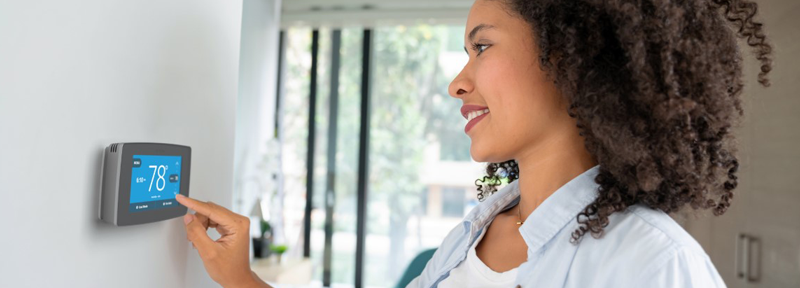
The heat of summer is in full swing, and you’re likely cranking up your air conditioner to compensate. However, once the electricity bill comes in, you may start looking for ways to save on energy so your costs don’t continue to skyrocket during the summer months.
The lower your thermostat setting, the higher your energy bills, which means it’s a delicate balancing act when it comes to finding the best temperature for both your comfort and wallet. Adjusting your thermostat properly and exploring additional cooling methods to help supplement can have a major impact on your overall savings and home comfort.
Best Temperature Settings While at Home
The U.S. Department of Energy recommends setting your thermostat at 78°F while you are at home during the summer, rather than keeping it low and cold like most of us are tempted to do. In most settings, this temperature level keeps your home reasonably cool and prevents a high energy bill. Did you know? A higher temperature indoors during the summer actually slows down heat entering your house, resulting in lower energy expenditure. The closer the temperature is between the indoors and outdoors, the lower your costs will be.
According to the U.S. Department of Energy, homes can save as much as 10% a year on average by turning their thermostats back 7-10°F from the normal setting for 8 hours a day. During the summer, this means turning it up 7-10°F higher than the set 78°F. These savings can depend on the climate of the area you live in. A milder climate will result in greater overall savings, but a hotter, more extreme climate may not benefit as much.
Best Temperature Settings When Away from Home
When you are not at home and you don’t have pets, there is no reason for your air conditioner to keep pumping out cold air. Turning up a higher temperature while you are gone for a few hours can save you a lot of money on cooling costs.
For instance, if you normally set your thermostat at 78°F while at home in the summer, set it to 88°F when you are at work or out for part of the day. Since the higher temperature slows heat flow into the house, it will take less energy to cool it back down to comfortable levels when you are coming home. This way, your air conditioner doesn’t needlessly run when nobody is at home.
Best Thermostat for a Set Schedule
If you don’t have a programmable thermostat, the investment can pay for itself, especially if you know when you’ll be away from home. Programmable thermostats can be configured to raise or lower the temperature automatically according to specific times of the day or night. There are also WiFi thermostats that can be adjusted when you aren’t even in the house.
Humidity Levels
We have all experienced high humidity and know how it can turn an average summer day into nearly unbearable conditions. This happens because the moisture from humidity makes it difficult for sweat to evaporate and leave the body, which results in discomfort and higher heat levels.
Most air conditioners perform well on their own when it comes to reducing humidity in the home. Some newer highly efficient air conditioners have settings on them for dehumidification; check with your HVAC contractor to make sure that your system is optimized for humidity removal. If you don’t want your air conditioner doing all the work, a dehumidifier can help reduce some of the humidity. The EPA recommends keeping humidity levels between 30-50% during the summer.
How to Maximize Cooling & Save Energy
You may be concerned that 78°F is still too high for comfort, but there are other methods to help maximize your house’s cooling. Many of these cooling strategies are easy and inexpensive to implement for greater energy savings.
- System tune-up: Have your HVAC contractor come out and make sure that your AC system is running at its optimum for efficiency and effectiveness.
- System fan: Newer indoor furnaces or air handlers have a setting that enables the blower in the equipment to operate 24/7 to circulate the air around the house and reduce hot spots.
- Window treatments and coverings: Installing window coverings or interior window treatments can reduce energy loss. Roughly 30% of heating energy is lost through a home’s windows, making them a major factor in keeping a house cool during the hotter months.
- Use ceiling fans: Ceiling fans efficiently cool down the spaces that they are in. Just make sure to turn them off when you leave the room so that they don’t run unnecessarily. Most ceiling fans have a switch that reverses airflow; you want air directed downward in the summer (makes you feel cooler by evaporating any sweat on your skin) and upward in the winter (takes the warmer air off of the ceiling and directs it downward to mix with cooler air).
- Limit appliance and artificial lighting use: When possible, limit the use of appliances that create heat, such as ovens, washing machines, dishwashers, etc. Also, try to use natural lighting as much as is convenient so that your artificial lights generate less heat.
- Update caulk or weatherstripping: Install new caulking or weatherstripping around your doors and windows to seal in air leaks.
- Eves/Roof vents: If you have an attic, make sure your eves/roof vents are free of debris and are moving the hot air across and out of the attic to lessen the heat load on your home’s ceilings.
Maintaining comfortable temperature levels in your home while also keeping costs down can be a delicate balancing act. However, following these recommendations will go a long way toward setting your home up for success this summer.
Read Next: HVAC in the News: Should I really set my thermostat to 78 degrees?



